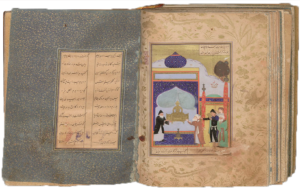A CEREMONY IN THE TEMPLE
“A CEREMONY IN THE TEMPLE”
XVI century. Herat school.
The miniature is executed for the “Bostan” of Saadi Shirazi.
This work is a facsimile copy of a miniature from the manuscript kept in the Museum of Turkish and Islamic art in Turkiye.

“The Bostan” (The Orchard) is the first major moralizing poem written by the brilliant Persian writer Saadi Shirazi in 1257. In his composition of ten chapters, written in the genre of wise reasoning, Saadi touches on political, social, moral and ethical issues, and, as it befits a sage of the East, gives various advice. In an entertaining way, the author narrates his travels and adventures in different countries. One of these stories in the poem is dedicated to Saadi’s journey to India.
At the Indian Somnath, in a temple Saadi saw an idol, which was of great worship. The faith of the idolaters was supported by a miracle: every day at dawn the statue, as if alive, raised its hand. Saadi learned what the secret of the idol was – one of the temple attendants, hiding behind a curtain, manipulated the statue with a rope. Saadi killed the cheating servant, broke the statue and fled away.
The miniature depicted on the right-hand side of a double page of the book illustrates “The story of Saadi and the idolaters” from the “Bostan” which is dedicated to the poet’s journey to India and the misdeeds of the pagans.
The main events depicted in the miniature take place in the temple. In the mihrab part of the architectural structure there is a golden sculpture of Buddha sitting on a golden throne.
On the right side of the main image is Saadi Shirazi, who was captured during his journey to India and forced to convert to Buddhism. On the left is the Brahman greeting Shirazi, wearing a black robe and black headdress and holding a white rosary in his right hand. A ritual smoking vessel is depicted between them.
On the right there are three male figures of different ages: one holds a book; another is depicted with his hands raised in supplication; the third is an old man holding prayer beads. At first glance, this group of watching people on the right side of the miniature seems to be of different religions.
The main background of the temple walls and dome are made in a dark blue color, on which a flourish pattern of small red, yellow and white flowers is depicted. At the temple entrance are two columns decorated with red and gold-woven curtains with a flourish ornament.
The vegetation and trees depicted in the background are painted in dark green.
Presumably, the image of a bowed white bird depicted on a tree reflects the allegorical meaning of apostasy (“broken”, “betrayed” religion).
The image of a golden sky indicates daylight hours.
In the upper left corner and the bottom part of the miniature there is an accompanying text.
КK-614. INV–166